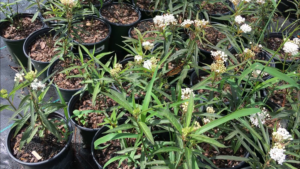S & J Nursery’s Guide to Growing
Florida Native White Swamp Milkweed/ Aquatic Milkweed
for the Northeast Florida Landscape
(Asclepias perennis)
Aquatic Milkweed AKA White Swamp Milkweed is a Florida native plant that can be found growing in its natural habitat in moist to wet soils in Florida and in a full sun location.
A WORD ABOUT PESTICIDES ON MILKWEEDS
Grown as a larval plant for the Monarch, Queen and Soldier Butterfly, our butterfly plants are grown here on site from seed, cuttings, or divisions and not treated with herbicides or pesticides. See Pesticides on Butterfly Plants for more information.
Preferred Exposure for Asclepias perennis / White Swamp Milkweed / Aquatic Milkweed:
– Prefers a bright full sun location but will still grow and bloom nicely in a
partially shaded garden location.
Foliage, Size and Growth Habit of the Asclepias perennis / White Swamp
Milkweed / Aquatic Milkweed:
Foliage: Narrow opposite foliage is 3-5 in in length and
1-4 cm in width. It attaches to the reddish or purplish green stems with short petioles. Swirls up the stem is 4 to 6 inches in length, sometimes longer and deciduous, loosing its leaves during the winter time.
Size when Mature: It can grow to a height of 1-2 ft high and 2 ft
wide.
Soil Preference / Salt tolerance of Florida Native Milkweed Asclepias Perennis:
Soil Preference: Aquatic milkweed is not that particular about the soil that it is
planted into, providing it receives consistent moisture that most modern landscapes provide. It grows nicely in well draining but irrigated areas, and will thrive when planted into moist or even wet area soils. It is the perfect plant for those garden areas that tend to stay wet near gutter downspouts, low spots or areas where sidewalks may cause slower drainage after heavy
rains etc where other landscape plants may struggle to survive.
– Aquatic milkweeds natural habitat would be wet ditches, bog areas, wetlands near creeks, retention ponds, flood plains etc. If you are like me and have a well drained sandy soil garden with little to no irrigation, consider planting your Asclepias perennis in a container with no drain holes in it! i have had great success with home made planters with no bottom drain and drain holes drilled on the sides of the pots about 6 inches from the top to keep them moist
Salt tolerance: Salt tolerance for Asclepias perennis is poor.
Growth Rate:
– Moderate growing plants, Native White Swamp milkweed can be expected to reach its full height in the second growing season if planted early in the year when planted in the North Florida | Jacksonville | St. Augustine area landscape.
Blooms:
– Bright white blooms that are recognizable by their typical milkweed pattern and petal count. Asclepias perennis will have clusters of flowers that each have 10 petals , 5 down and outward facing petals and 5 upward facing petals.
Water Requirements:
– Asclepias perennis will maintain a moderate to high level of water
needs particularly in the heat of our Northeast Florida summer. Remember to give your existing plantings supplemental watering when first planted into the landscape from a container and during and times of drought.
Butterfly or Bird Attracting:
– Native Milkweeds will attract both butterflies and birds to your
gardens landscape. It is a larval food source for Monarch, Queen and Soldier Butterflies as well as providing pollen for other native pollinators including butterflies and bees. Butterflies and other pollinators will
eagerly feed on the nectar the flowers provide from spring through fall.
Care of Asclepias perennis in the Northeast Florida | Jacksonville | St. Augustine area landscape:
– Water every other day during the establishment period after planting in the garden from a nursery container, once plants have established themselves into the landscape taper water back to just a once to twice a week application during prolonged droughts.
– Herbaceous perennial plant.
– Fertilize each spring with a shovel full of good garden compost.
Click here for more information on
Asclepias perennis / White Swamp Milkweed
/ Aquatic Milkweed
for the North Florida | Jacksonville | St. Augustine area landscape from the Florida Native Plant Association.
https://www.floridamuseum.ufl.edu/wildflower/completeWildflowerData.asp?id=5


